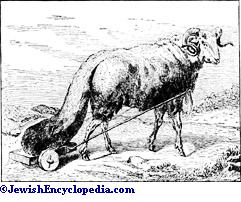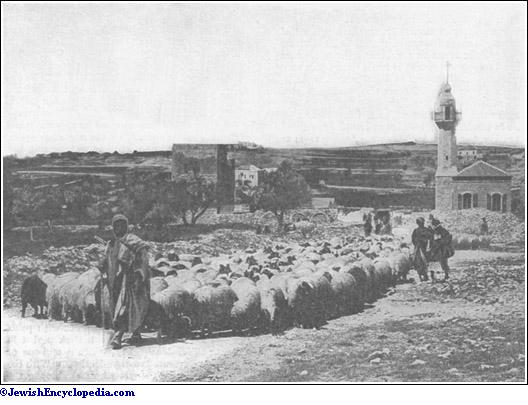SHEEP.
The most usual terms for the sheep are "seh" and "kebes" ("keseb"); "kar" (Deut. xxxii. 14; Isa. lviii. 7) denotes the young lamb in pasture; "ṭeleh" (Isa. xl. 11 et al.), the suckling lamb; "ayil," the ram; "raḥel," the ewe. In the Aramaic portions of the Old Testament the term "emer" occurs (Ezra vii. 17), which term is found also in the cognate languages. The word "ẓon" is used collectively for small cattle, including sheep and goats.
Uses of the Sheep.The important place held by the sheep in the husbandry of Palestine is shown by the hundreds of Biblical references to it. It is the first animal distinguished by name (Gen. iv. 4). In patriarchal times sheep formed the chief part of the flocks and herds and the principal source of wealth (comp. Gen. xii. 16, xxiv. 35 et al.; Ex. ii. 16). The existence of large numbers of sheep is referred to throughout the Biblical narrative (comp. Num. xxxi. 32; Josh. vi. 21; I Sam. xiv. 32, xv. 3, xxvii. 9; Job i. 3; I Chron. v. 21). Even kings did not disdain to be breeders of sheep (II Kings iii. 4; I Chron. xxvii. 31; II Chron. xxvi. 10, xxxii. 29; comp. Eccl. ii. 7).
The uses of the sheep were manifold. Its flesh, especially that of lambs, was a favorite dish (I Sam. xxv. 18; I Kings iv. 23; Isa. xxii. 13; Amos vi. 4); the ewe's milk also was consumed (Deut. xxxii. 14). The shofar was made of the horn of the ram (Josh. vi. 4), which was used also as a receptacle for oil, etc. (I Sam. xvi. 1). The skin served as covering for tents (Ex. xxvi. 14), and probably as clothing (Heb. xi. 37). But it was chiefly for its wool that the sheep was valued (Deut. xviii. 4; Prov. xxvii. 23, 26; xxxi. 13; Job xxxi. 19), and sheep-shearing was the occasion of a festival (Gen. xxxviii. 12; I Sam. xxv. 2; II Sam. xiii. 23). The white wool of Damascus is especially mentioned (Ezek. xxvii. 18).

The sheep was preeminently the animal for sacrifice (Gen. iv. 4; Lev. i. 10 et passim; I Kings viii. 5; II Chron. xv. 11). The morning and evening offering in the Sanctuary consisted of a yearling lamb (Ex. xxix. 38; Num. xxviii. 1).
The plain east of the Jordan, and Ammon, Moab, Gilead, Bashan, Carmel, and Sharon were particularly devoted to sheep pasture (Num. xxxii. 4; Isa. lxv. 10; Micah vii. 14; II Kings iii. 4). Arabia also was rich in sheep (Isa. lx. 7; Ezek. xxvii. 21; II Chron. xvii. 11).
The sheep now most common in Palestine is the broad-tailed variety, characterized by a deposit of fat in the tail ("alyah"; comp. Ex. xxix. 22; Lev. iii, 9 et al.). In northern Palestine a horned variety similar to the merino is found. Sheep are still abundant east of the Jordan.
Flock and shepherd are often used figuratively in reference to the people and their leaders (Num. xxvii. 17; I Kings xxii. 17; Ezek. xxxiv. 17, xxxix. 18; Zech. xi. 7; Ps. xlix. 15, cxix. 176). The ram is also the emblem of one of the great monarchies (Dan. viii. 3). The patience and meekness of the lamb are alluded to in Isa. liii. 7, Jer. xi. 19, and Ps. xliv. 12, 23 (A. V. 11, 22).
—In Rabbinical Literature:A number of additional terms for the sheep are used in the Talmud; e.g.,  (Ker. 28b et al.),
(Ker. 28b et al.),  (R. H. 26a). In the first month of the second year the sheep is called
(R. H. 26a). In the first month of the second year the sheep is called  (Parah i. 3). The ram is called also
(Parah i. 3). The ram is called also  ("the male of the ewes"; Yeb. 121b), and in the plural
("the male of the ewes"; Yeb. 121b), and in the plural  (Ḥul. 39b); while to the great ram the term
(Ḥul. 39b); while to the great ram the term  is applied (Shab. 18b),
is applied (Shab. 18b),  (properly, "he-goats") occurs sometimes for sheep in general (Ḥul. 84a). The wild ram is
(properly, "he-goats") occurs sometimes for sheep in general (Ḥul. 84a). The wild ram is  ("ram of the field"; Ḥul. 80a). Sheep carrying their heavy tails on little wagons are mentioned (Shab. 54b).
("ram of the field"; Ḥul. 80a). Sheep carrying their heavy tails on little wagons are mentioned (Shab. 54b).
The high estimation in which sheep are held in the Talmud is illustrated by the advice: "Sell thy field to buy sheep, but do not sell thy sheep to buy a field" (Ḥul. 84a, b). The most valuable part of the sheep is its wool, and great pains were taken in the care of it (Shab. 6b; Ḥul. 137a). Sheep bearing fine wool were protected by covers to keep the wool clean (Shab. 54a). Shorn sheep wore on the forehead a sponge or a piece of woolen cloth saturated in oil as a protection against cold (ib.). Of the ram, the horns were made into wind-instruments, the hollow thigh-bones into flutes, the large intestine into lute-strings, and the small intestine into harp-strings; while from its wool were made the pomegranates in the garment of the high priest, against which the striking of small golden bells produced a tinkling sound (comp. Ex. xxviii. 33-35). Hence the adage: "The ram alive produces only one sound; dead, seven sounds" (Ḳin. 25a). The sheep conceives, as a rule, when it is two years old, and its period of gestation is five months. It copulates with the goat (Bek. 19b). In parturition the young comes forth with the lips first, not with the ears, as does the goat (Bek. 35a). To aid the sheep in parturition pieces of cloth dipped in oil and warmed were bound on its forehead and belly (Shab. 54b). To fatten female sheep their udders were bound up so as to prevent the formation of milk (Shab. 54a). The best sheep were those of Hebron (Soṭah 34b).

- Tristram, Nat. Hist. p. 133;
- Lewysohn, Zoologie des Talmuds, p. 118.

